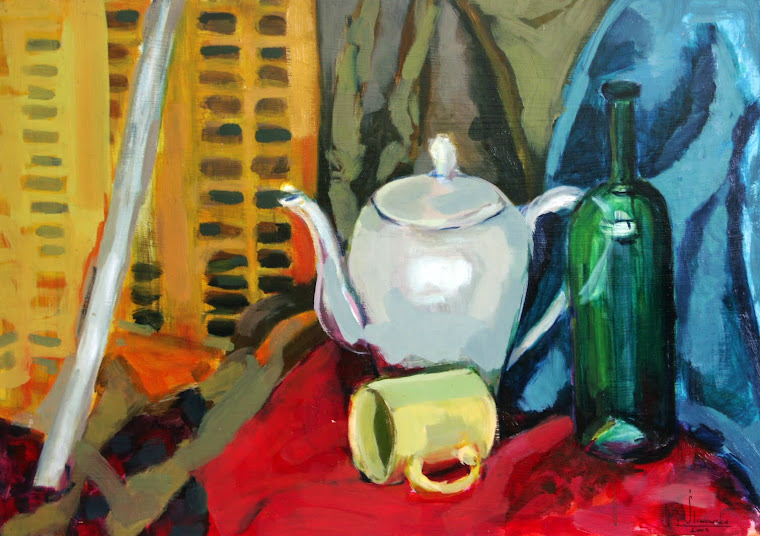CHAPTER 2: COLOUR THEORY AND PRACTICE
PROJECT 1:”Colour Mixing”
Stage 1: Mixing Colours
In this project I have been asked to paint each primary colour (cadmium red, cadmium yellow, ultramarine) at the top (one about 4cm square), the colour must be clean, unmixed, straight from the tube. Below them are three groups of five squares of colour, the orange is mixed from yellow and red only, the green from yellow and blue, and the third from blue and red.
Stage2: Adding Black or White to Colours
As I have my first stage completed, the next step was to take a colour from each of the three groups of colours from above. Orange with a very small amount of black for the top square, I was continuing adding black until I have reached almost black. The same process was with white colour.
PROJECT 2: “The Colour Circle”
This little project shows colours in a circular sequence that corresponds with the order of spectrum colours that make up white light.
1) Cadmium Red +Crimson
2) Cadmium Red
3) Cadmium Red + Cadmium Yellow
4) Cadmium Yellow
5) Cadmium Yellow + Lemon Yellow
6) Lemon Yellow
7) Lemon Yellow + Cerulean Blue
8) Cerulean Blue
9) Cerulean Blue + Ultramarine
10) Ultramarine
11) Ultramarine + Crimson
12) Crimson
Through this project, I could find out more about complementary colours, which we call colours opposite to each other.
PROJECT 3: Tone, Saturation and Contrast
Stage 1: Tone Values
On the grid in the left hand column, I used black and white to gain grey. Then, on another piece of paper, I painted twelve squares using colours from the previous project. Next, I cut them out and matched the lightness or darkness of the colour against the greys.
When I look at my finished project, I see I made a mistake in the first column of grey under the white, there should be only one yellow, and I should leave lemon yellow only. However, I am pleased with the rest of my decision.
Stage 2: Saturation
Just like in stage 1, I have to take two colours and merge them, this time red and green, yellow and violet, blue and orange.
I was very surprised how the redness comes through, even in the middle of mixing yellow and violet the result is obvious.
PROJECT 4: How colours affect each other
This was my favourite exercise so far. I had to make sets of three squares, paint the small squares in the same identical colour. In one set the small squares grey, but the others should be any colour I wanted.
Colour theory says: that warm colours appear to advance to the foreground in a painting and cold colours to recede to the background, I can say it is true. It is easy to see on those grids:
I wanted to check what would happen when the small square is cold and the big one is cold temperature. I may say that darker colours always come to the foreground. When the small square is cold and the big one is warm temperature, the warm comes to the foreground. It was a bit different when I used warm temperature in both squares; darker colour comes to the foreground. As I saw with the yellow small squares, they came to the front while the cold big squares stayed in the background. Although there is a different with grey colour, it is so powerful that in most cases will appear to the foreground.
PROJECT 5: Optical Illusions
Stage 1: Optical Mixing
When I mixed small dots of yellow and blue next to each other, I suddenly saw green. When I did the same with reds and yellows, I saw orange. The last stage of this task was to check what would happen with red and blue, to my surprise it appeared to be violet.
Stage2: Inducing Colours
For the task I bought a light grey A2 size paper, I painted a cross (about two cm thick) at the top of the paper. As I was concentrating on looking at this red cross for more than thirty seconds my eyes believed that the cross was green.
Stage 3: What have I Achieved?
After all projects and exercises with colours, I feel more confident how I should use them. My knowledge about complementary colours, hue, and saturation has definitely improved so I can use that in my next work.
 drawing 1
drawing 1




























